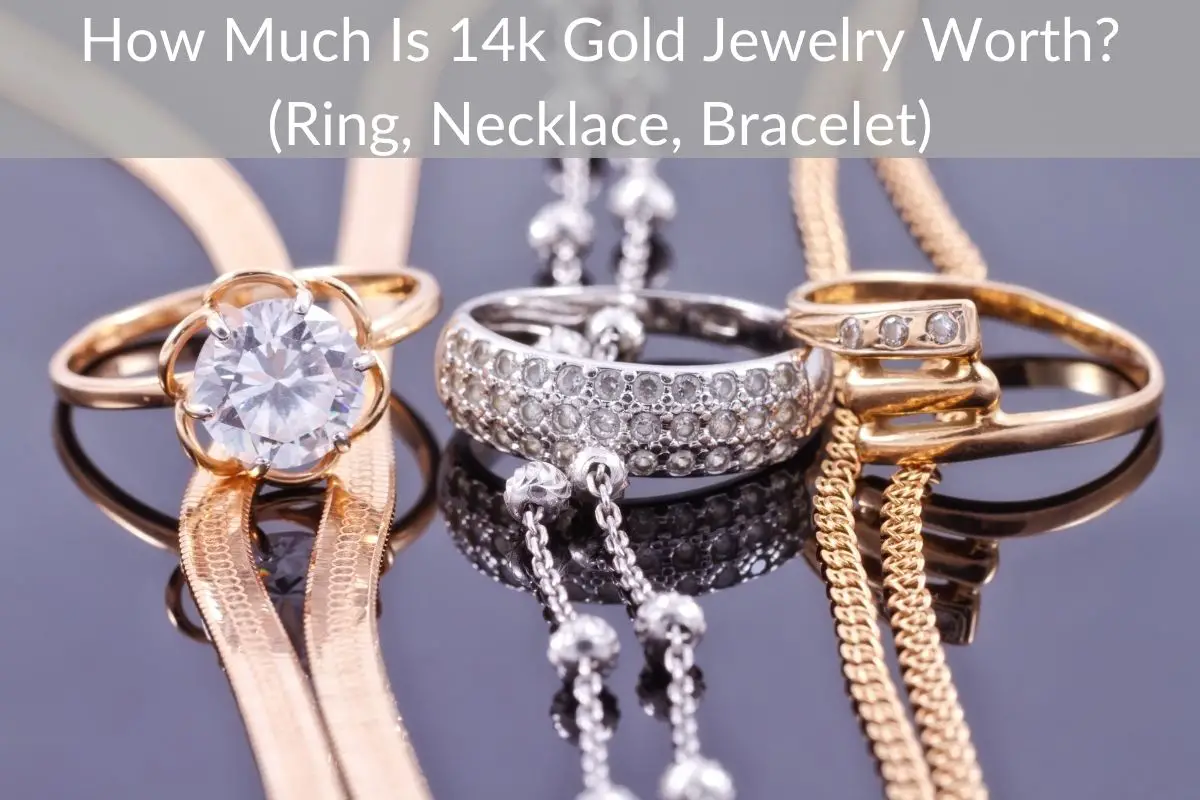Table of Contents
Jewelry is a lady’s best friend, and the more expensive, the better! But have you ever wondered about the cost of gold jewelry compared to the price per ounce of gold on the metals market? Or what makes one type of gold jewelry more expensive than another?
*This post may contain affiliate links. As an Amazon Associate we earn from qualifying purchases.
The question of how much 14k gold jewelry is worth is not as simple. You see, you first have to decide which type of value we’re talking about because there are different values in different contexts —and then there’s lots of math behind it too!
Generally, gold value is calculated using three main types of value:
- Intrinsic/Cash value
- Resale value
- Appraised value
Using the cash or intrinsic value, 1 gram of 14k gold jewelry will be worth approximately $ 36.363 and 1 once; $ 1,131.9. But there’s a lot more to consider when considering the value, so let’s break it down and see if we can figure out how much 14k gold jewelry is worth.
1. Intrinsic Value or Cash Value
Intrinsic value (also called cash value, cash wholesale value, or scrap value) is the simplest formula to understand. The equation for intrinsic value is:
intrinsic value = metal value + gem value
In the current market, metal (gold, silver, platinum, etc.) and gems (diamonds, sapphires, emeralds, etc.) are valued as raw materials based on rates. Simply put, gold jewelry value is primarily determined by the market spot price of gold.
Gold is divided into several groups according to its purity. The gold is divided into; 10K, 14K, 18K, and 24K in the US. However, you’re going to find other variations of groupings throughout the world.
So, 24K gold is 99% pure and the most expensive. 14K gold jewelry will thus have 58.3% of pure gold, so its value is a bit lower. Keep in mind that gold is considered a soft metal, so it has to be mixed in with other alloys to make the jewelry firm and resistant to scratching and damage.
Let me give you an example.
Let’s assume that your ring, necklace, or bracelet is made of 5 grams of 14k gold and has a 0.25-carat diamond. At $1,300 per ounce, the gold will have a value of $121 and a diamond value of roughly $250. That makes its intrinsic value $371.
Here’s how to calculate it:
- Kitco.com is an excellent place to start. This is where you get the daily gold spot price in dollars per troy ounce
- Convert the price you see into dollars per gram by dividing it by 31.1, which will give you $41.80 per gram.
- Now you need to multiply that by the gold purity of the jewelry. As I’ve mentioned before, 14 karat gold is roughly 58% gold, the remaining 42% is made from alloy
materials.
Calculating the diamond price is more complicated. It’s based on the wholesale price modified by the cut grade of the gem. The wholesale price changes daily, arranged by shape, size, color, and clarity.
2. Resale Value or Retail/Wholesale Price
Typically, used jewelry has a higher resale value than its intrinsic value because this price includes the intrinsic value and the workmanship to create the jewelry. Additionally, if there’s an increased demand for jewelry on the market, then a design premium is added.
The equation for resale value is:
resale value = intrinsic value + workmanship + style
Keep in mind that this isn’t exact, and there are other factors that can influence the resale value as well, for example, the melt price.
The melt price refers to the actual cost that the jeweler receives from a refiner if they choose to melt it down and just be paid for the value of the gold.
This price is never constant and changes daily. Remember that this price does not include other factors such as:
- The labor to create the jewelry
- Any additional stones (diamonds, emeralds, etc.)
- Margin for profit
3. Appraised Value or Replacement Cost
This is perhaps the most confusing value, yet it seems to be the simplest on the surface. Most people are aware of the appraised value of the jewelry.
The appraised value is only theoretical and does not refer to the worth of the jewelry. There are several types of appraisals, but most people are familiar with insurance appraisals. This is where most of the confusion comes from. You see, jewelry insurance appraisals don’t have anything to do with the worth of the jewelry item, only its replacement cost.
So, the purpose of a jewelry insurance appraisal is to figure out what it would cost to replace the item if it is lost, stolen, or damaged. It has nothing to do with the market value of the item that you have in your possession. Most times, your jewelry is worth about 5 to 20% of the appraised value.
4. New Value vs. Used Value
Many factors come into play when it comes to determining the value of new jewelry, and I’ve already touched on a few of them before.
Other factors I haven’t mentioned include:
- Wholesale costs
- Import costs
- Marketing costs
- Transportation costs
Additionally, the higher end the retailer, the more expensive the jewelry. Branding is everything! The same engagement ring at Tiffany & Co will cost a lot less in a lower-end establishment. Moreover, internal factors such as the sales commission of the staff, overhead costs, and regulatory factors like taxes all contribute to the value of your jewelry.
As a result of all these variations, it’s clear that the price you’d pay for your 14k gold ring, necklace, or bracelet is way above what it’s worth. The current pricing model is primarily based on the factors I’ve discussed.
Conclusion
So how much is 14k gold jewelry worth? It’s worth its intrinsic value. Every other factor is variable.
If you want to know more about the worth of your other jewelry, I suggest getting the help of a professional gemologist who can explain each of the values to you in detail.

